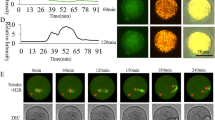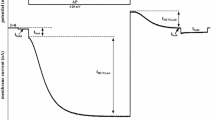Abstract
The relationship between capacitative Ca2+ influx and activation of Ca2+-dependent Cl− channels was monitored in intactXenopus oocytes following stimulation of 5-hydroxytryptamine (5-HT) receptors, through the activity of Ca2+-dependent Cl− channels using the double-electrode voltage-clamp technique. Under voltage-clamp conditions, 5-HT evoked a rapid transient inward current followed by a slowly developing secondary inward current. The secondary current reflected depletion-activated Ca2+ entry. Hyperpolarising pulses evoked sustained Ca2+-dependent Cl− currents when applied during the transient inward current, but evoked hump-like currents which inactivated rapidly when applied during the secondary inward current. Hump currents arose from Ca2+ entering through the depletion-activated pathway. The hump currents inactivated with hyperpolarising pulses at <5-s intervals, and recovered monoexponentially with a time constant of around 8 s. Currents in response to hyperpolarising pulses during the transient current did not inactivate, suggesting that inactivation was associated with Ca2+ entry. When Ca2+ release evoked by inositol 1,4,5-triphosphate [Ins(1,4,5)P 3] was prevented by heparin injection, hyperpolarising pulses during Ca2+ ionophore application also generated hump currents that were dependent on external Ca2+, inactivated and recovered from inactivation with a similar time course as the humps following 5-HT treatment. Pretreatment with the Ca2+ adenosine 5′-triphosphatase (Ca2+ATPase) inhibitor thapsigargin reduced the rate of rise of the hump current, increased the time-to-peak of the current and slowed the rate of decay. Pharmacological interventions to disrupt the cytoskeleton reduced the amplitude of the hump current. It is suggested that, following hyperpolarisation in the presence of Ca2+ entry, the ensuing Ca2+ influx interacts with Cl− channels in a way that might reflect both Ca2+ inhibition of Ca2+ entry and clustering of Cl− channels in the plasma membrane.
Similar content being viewed by others
References
Berridge MJ (1993) Inositol trisphosphate and calcium signalling. Nature 361:315–325
Tsien RW Tsien RY (1990) Calcium channels, stores and oscillations. Annu Rev Cell Biol 6:715–760
Putney JW Jr (1986) A model for receptor-regulated calcium entry. Cell Calcium 7:1–12
Parekh AB, Foguet M, Lübbert H, Stühmer W (1993) Ca oscillations and Ca influx inXenopus oocytes expressing a novel 5-hydroxytryptamine receptor. J Physiol (Lond) 469:653–671
Girard S, Clapham DE (1993) Acceleration of intracellular calcium waves in Xenopus oocytes by calcium influx. Science 260:229–232
Yao Y, Parker I (1994) Ca2+ influx modulation of temporal and spatial patterns of inositol trisphosphate-mediated Ca2+ liberation in Xenopus oocytes. J Physiol (Lond) 476:17–28
Dascal N (1987) The use of Xenopus oocytes for the study of ion channels. CRC Crit Rev Biochem 22:317–387
Parekh AB, Terlau H, Stühmer W (1993) Depletion of InsP3 stores activates a Ca and K current by means of a phosphatase and a diffusible messenger. Nature 364:814–818
Yao Y, Parker I (1993) Inositol trisphosphate-mediated Ca influx into Xenopus oocytes triggers Ca liberation from intra-cellular stores. J Physiol (Lond) 468:275–296
Hoth M, Penner R (1992) Depletion of intracellular calcium stores activates a calcium current in mast cells. Nature 355:353–355
Fasolato C, Hoth M, Penner R (1993) A GTP-dependent step in the activation of capacitative calcium influx. J Biol Chem 268:20737–20740
Stühmer W (1992). Electrophysiological recordings from Xenopus oocytes. Methods Enzymol 207:319–339
Lübbert H, Hoffman BJ, Van-Dyke T, Hartig PR, Lester HA, Davidson N (1987) cDNA cloning of a serotonin 5-HT1C receptor by electrophysiological assays of mRNA-injected Xenopus oocytes. Proc Nat Acad Sci USA 84:4332–4336
Petersen CCH, Berridge MJ (1994) The regulation of capacitative calcium entry by calcium and protein kinase C inXenopus oocytes. J Biol Chem 269:32246–32253
Parker I, Yao Y (1994) Relationship between intracellular Ca signals and Ca-activated Cl current in Xenopus oocytes. Cell Calcium 15:276–288
Parker I, Gundersen CB, Miledi R (1985) A transient inward current elicited by hyperpolarisation duting serotonin activation in Xenopus oocytes. Proc R Soc Lond [Biol] 233:279–292
Fasolato C, Pozzan T (1989) Effect of membrane potential on divalent cation transport catalyzed by the “electroneutral” ionophores A23187 and ionomycin. J Biol Chem 264: 19630–19636
Eberhard DA, Holz RW (1988) Intracellular Ca2+ activates phospholipase C. Trends Neurosci 11:517–520
Peter AB, Schittney JC, Niggli V, Reuter H, Sigel E (1991) The polarized distribution of poly(A)-mRNA-induced functional ion channels in the Xenopus oocyte plasma membrane is prevented by anti-cytoskeletal drugs. J Cell Biol 114:455–464
Irvine RF (1990) ‘Quantal’ Ca2+ release and the control of Ca2+ entry by inositol polyphosphates—a possible mechanism. FEBS Lett 263:5–9
Nomura Y, Kaneko S, Kato K, Yamagishi S, Sugiyama H (1987) Inositol phosphate formation and chloride current responses induced by acetylcholine and serotonin through GTP-binding proteins in Xenopus oocyte after injection of rat brain messenger RNA. Mol Brain Res 2:113–123
Albritton NL, Meyer T, Stryer L (1991) Range of messenger action of calcium ion and inositol, 1,4,5-trisphosphate. Science 258:1812–1815
McDonald TV, Premack BA, Gardner P (1993) Flash photolysis of caged inositol 1,4,5-trisphosphate activates plasma membrane calcium current in human T cells. J Biol Chem 268:3899–3996
Chad JE, Eckert R (1986) An enzymatic mechanism for calcium current inactivation in dialysed Helix neurones. J Physiol (Lond) 378:31–51
Ackerman MJ, Wickman KD, Clapham DE (1994) Hypotonicity activates a native chloride current in Xenopus oocytes. J Gen Physiol 103:153–179
Lupu-Meiri M, Shapira H, Oron Y (1988) Hemispheric asymmetry of rapid chloride responses to inositol trisphosphate and calcium in Xenopus oocytes. FEBS Lett 240:83–87
Miledi R, Parker I (1984) Chloride current induced by injections of calcium into Xenopus oocytes. J Physiol (Lond) 357:173–183
Marty A, Neher E (1985) Potassium channels in cultured bovine adrenal chromaffin cells. J Physiol (Lond) 367:117–141
Parker I, Ivorra I (1993) Confocal microfluometry of Ca signals in Xenopus oocytes by photoreleased inositol trisphosphate. J Physiol (Lond) 461:133–165
Collins A, Somlyo AV Hilgemann D (1992) The giant cardiac membrane patch method: stimulation of outward Na-Ca exchange current by MgATP. J Physiol (Lond) 454:27–57
Oron Y, Dascal N (1992) Regulation of intracellular calcium activity in Xenopus oocytes. Methods Enzymol 207:381–390
Author information
Authors and Affiliations
Rights and permissions
About this article
Cite this article
Parekh, A.B. Interaction between capacitative Ca2+ influx and Ca2+-dependent Cl− currents inXenopus oocytes. Pflugers Arch. 430, 954–963 (1995). https://doi.org/10.1007/BF01837409
Received:
Revised:
Accepted:
Issue Date:
DOI: https://doi.org/10.1007/BF01837409




